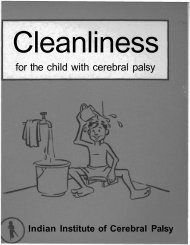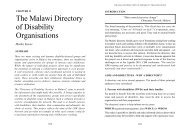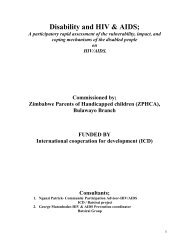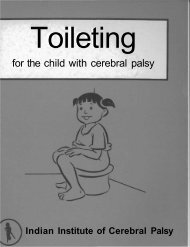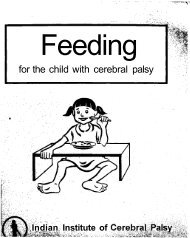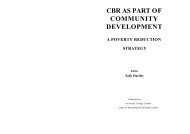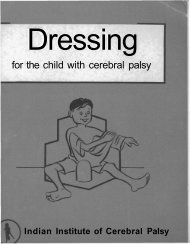Some Controversies in Community Based Rehabilitation - Source
Some Controversies in Community Based Rehabilitation - Source
Some Controversies in Community Based Rehabilitation - Source
Create successful ePaper yourself
Turn your PDF publications into a flip-book with our unique Google optimized e-Paper software.
CBR A PARTICIPATORY STRATEGY IN AFRICA<br />
However, even if CBR does reduce the f<strong>in</strong>ancial costs of the service<br />
provider, a question, which must be addressed, is, who carries the burden<br />
then In reality, the costs to consumers <strong>in</strong> terms of their efforts, time and<br />
money, may turn out to be much higher than what it is generally believed<br />
to be (Thomas and Thomas, 1998). The ‘cost effective’ aspects of<br />
promot<strong>in</strong>g community-based <strong>in</strong>terventions lie <strong>in</strong> the utilisation of<br />
community resources. These, often <strong>in</strong>volve different community members<br />
who volunteer their time and efforts, to help and support disabled persons<br />
and their families. The volunteers are often family members themselves,<br />
<strong>in</strong> which case another aspect for consideration might be the ‘emotional<br />
cost’ of this <strong>in</strong>volvement. How to measure emotional costs, how to value<br />
or cost life itself, is difficult to contemplate, and how such <strong>in</strong>formation<br />
can be compared with a f<strong>in</strong>ancial budget seems an impossible task.<br />
The po<strong>in</strong>t then is, whether the consumers are ready to take on the<br />
additional burden of the costs of CBR <strong>in</strong>terventions Secondly, even if<br />
they are will<strong>in</strong>g to do so, can they afford to do so Many families <strong>in</strong><br />
develop<strong>in</strong>g countries, who are struggl<strong>in</strong>g for their daily survival, feel<br />
that it is a waste of effort and money to address the rehabilitation needs<br />
of their disabled children, preferr<strong>in</strong>g <strong>in</strong>stead, to spend on other children<br />
without disability <strong>in</strong> the hope that they would support them <strong>in</strong> their old<br />
age. In an environment of <strong>in</strong>creas<strong>in</strong>g competition for resources, their<br />
reason<strong>in</strong>g is that unless the other children are well placed, they may not<br />
be <strong>in</strong> a position to support their disabled sibl<strong>in</strong>g <strong>in</strong> the future, especially<br />
s<strong>in</strong>ce few protective social security schemes are available <strong>in</strong> these<br />
countries (Iyanar, 2001). Until some of these issues are addressed, it is<br />
unlikely that consumers would be ready to bear the costs of the<br />
rehabilitation programme on their own.<br />
IS CBR THE ANSWER FOR ALL DISABLED PEOPLE<br />
OR ONLY FOR A SELECT FEW<br />
It is estimated that 70% of people with disabilities could be helped at<br />
the community level, while the rema<strong>in</strong><strong>in</strong>g 30%, compris<strong>in</strong>g of people<br />
with severe and multiple disabilities, require specialist <strong>in</strong>terventions that<br />
are not available <strong>in</strong> the community (WHO, 1981). Evaluations of CBR<br />
20



